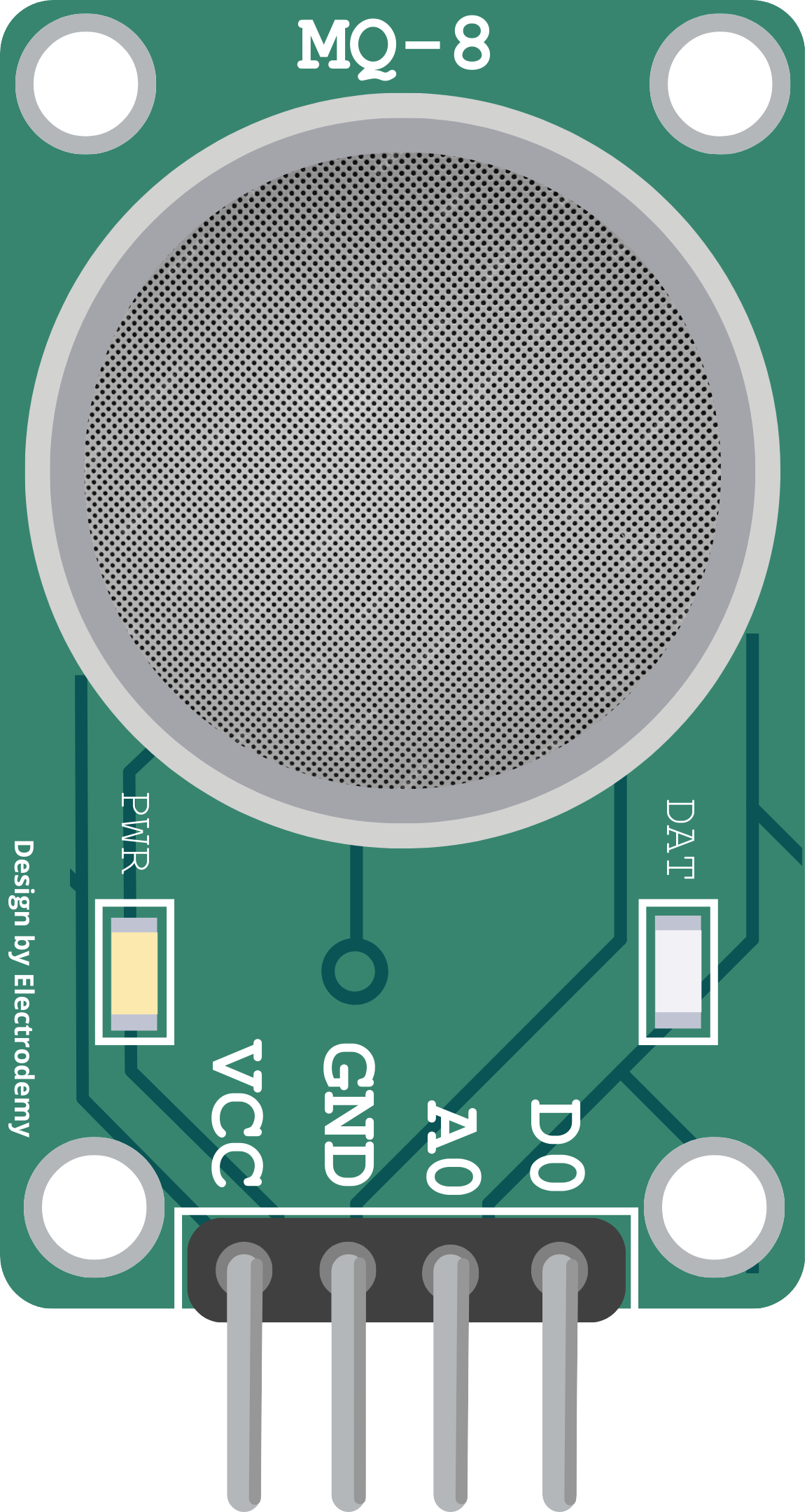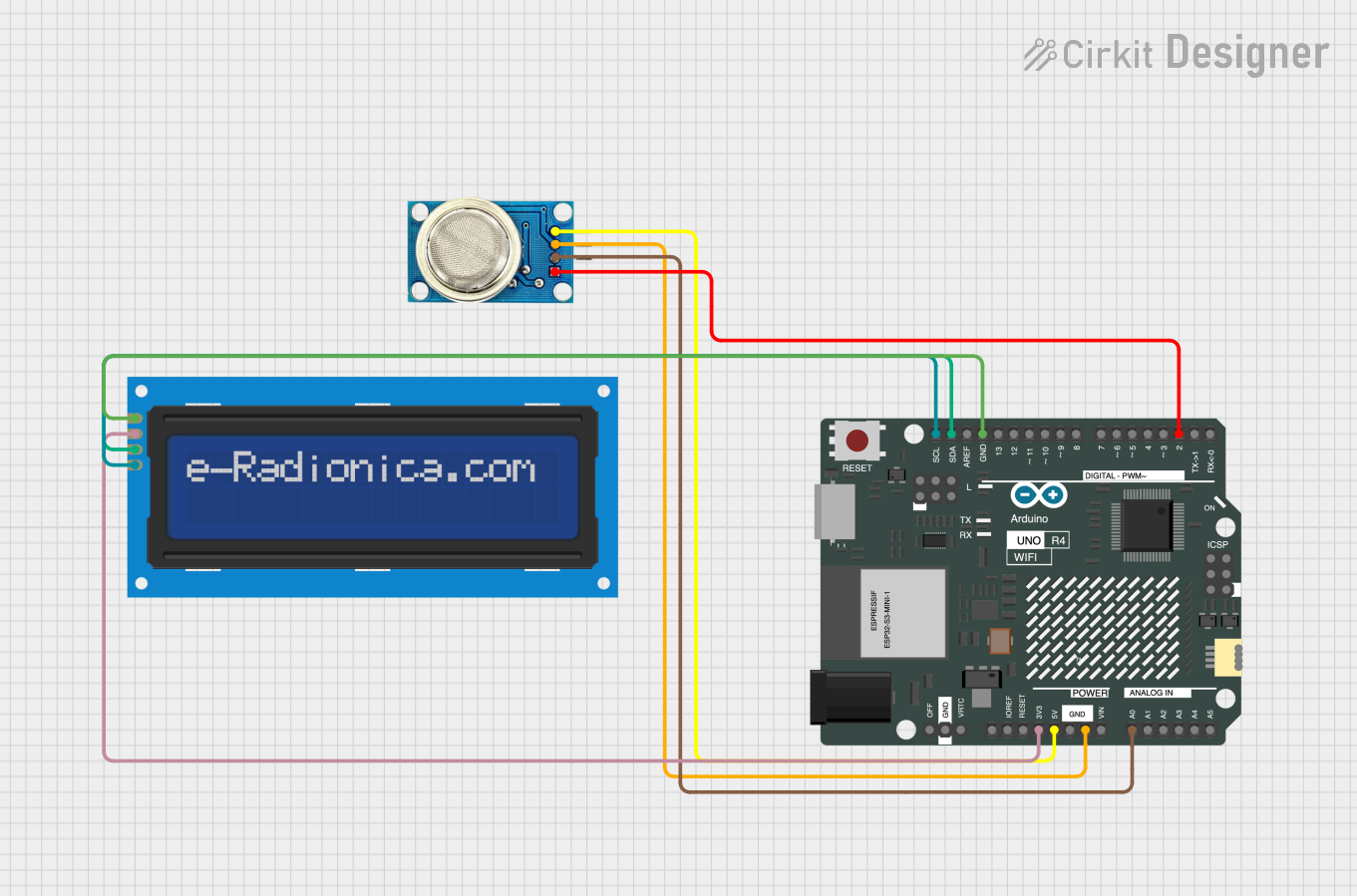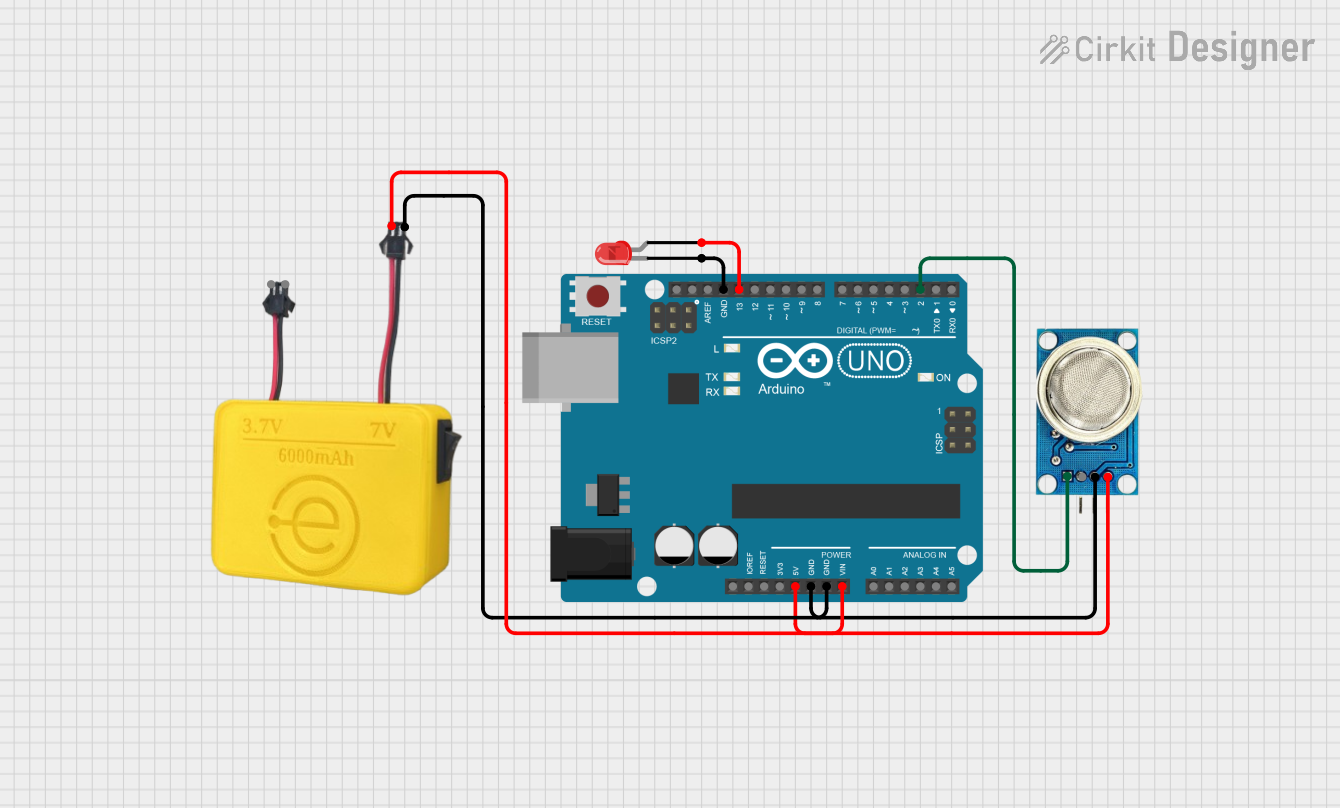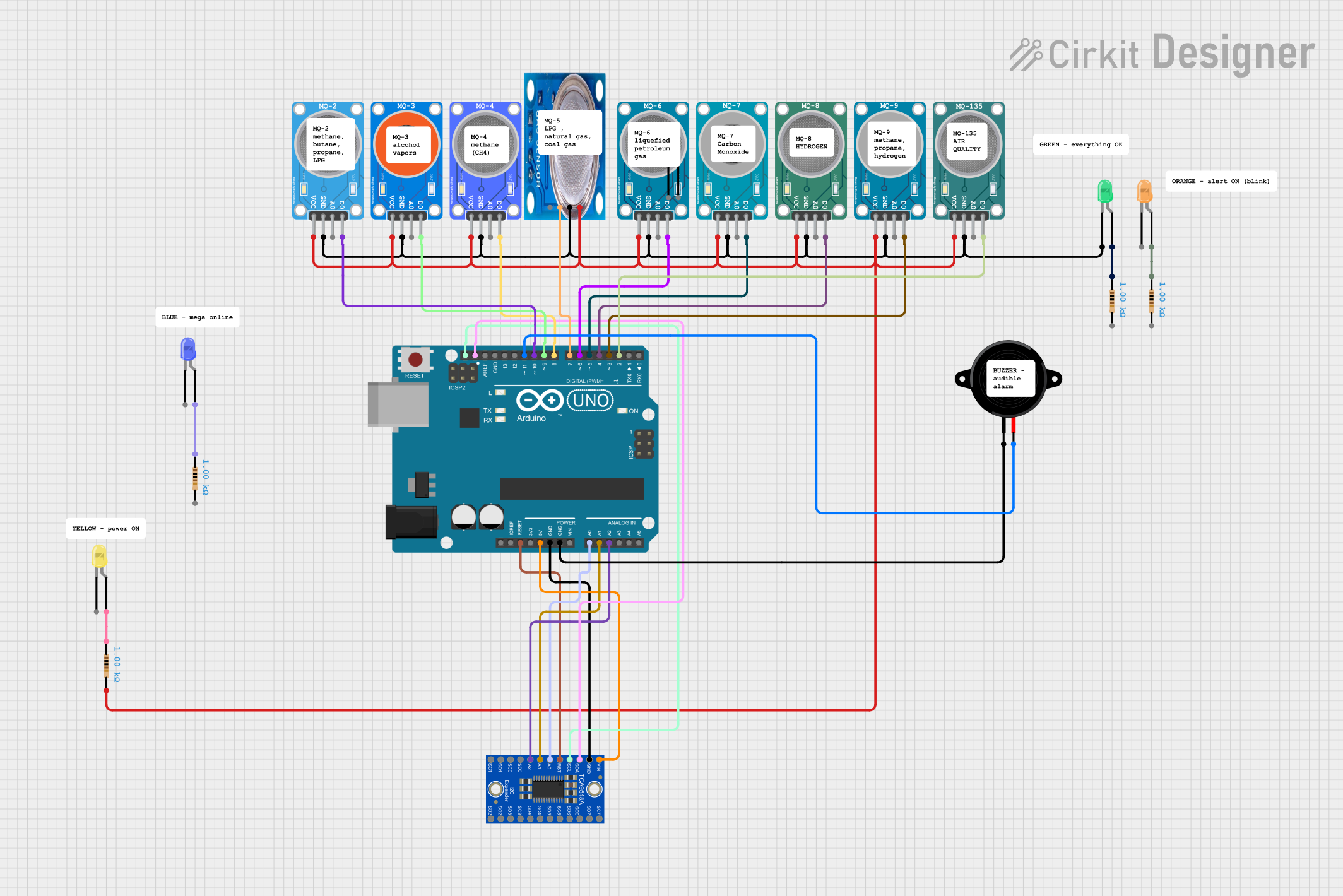
How to Use MQ-8 SENSOR HYDROGEN: Examples, Pinouts, and Specs

 Design with MQ-8 SENSOR HYDROGEN in Cirkit Designer
Design with MQ-8 SENSOR HYDROGEN in Cirkit DesignerIntroduction
The MQ-8 sensor is an electronic device designed to detect the presence of hydrogen gas (H2) in the air. It is widely used in various applications such as hydrogen gas leak detection systems, hydrogen storage units, and safety monitoring in environments where hydrogen is produced or used. The sensor operates on the principle that the conductivity of tin dioxide (SnO2) changes with the concentration of hydrogen gas in the air, providing a means to measure the gas concentration.
Explore Projects Built with MQ-8 SENSOR HYDROGEN

 Open Project in Cirkit Designer
Open Project in Cirkit Designer
 Open Project in Cirkit Designer
Open Project in Cirkit Designer
 Open Project in Cirkit Designer
Open Project in Cirkit Designer
 Open Project in Cirkit Designer
Open Project in Cirkit DesignerExplore Projects Built with MQ-8 SENSOR HYDROGEN

 Open Project in Cirkit Designer
Open Project in Cirkit Designer
 Open Project in Cirkit Designer
Open Project in Cirkit Designer
 Open Project in Cirkit Designer
Open Project in Cirkit Designer
 Open Project in Cirkit Designer
Open Project in Cirkit DesignerTechnical Specifications
Key Technical Details
- Target Gas: Hydrogen (H2)
- Detection Range: 100ppm to 10,000ppm
- Preheat Duration: 20 minutes (typical)
- Supply Voltage: 5V DC ±0.1V
- Heating Voltage: 5V ±0.1V (High), 1.5V (Low)
- Load Resistance: Adjustable
- Heater Resistance: 31Ω ± 3Ω (at room temperature)
- Heater Power Consumption: Approx. 800mW
- Operating Temperature: -10°C to 50°C
- Humidity Range: 95% RH or less (non-condensing)
Pin Configuration and Descriptions
| Pin Number | Pin Name | Description |
|---|---|---|
| 1 | VCC | Power supply (5V DC) |
| 2 | GND | Ground |
| 3 | DO | Digital output (TTL logic level) |
| 4 | AO | Analog output (proportional to gas level) |
Usage Instructions
Integration with a Circuit
- Power Supply: Connect the VCC pin to a 5V power supply and the GND pin to the ground.
- Analog Output (AO): Connect the AO pin to an analog input on your microcontroller to read the gas concentration as an analog voltage.
- Digital Output (DO): The DO pin can be connected to a digital input on your microcontroller. It outputs a low level when the hydrogen concentration reaches a certain threshold, which can be adjusted using the onboard potentiometer.
Important Considerations and Best Practices
- Calibration: The MQ-8 sensor requires calibration to ensure accurate readings. Expose the sensor to a known concentration of hydrogen gas and adjust the onboard potentiometer until the desired output is achieved.
- Preheating: Before taking measurements, allow the sensor to preheat for at least 20 minutes to stabilize its readings.
- Environmental Factors: Avoid using the sensor in environments with high concentrations of other gases or volatile organic compounds (VOCs) that may interfere with the sensor's readings.
- Safety: Hydrogen is a highly flammable gas. Ensure proper safety measures are in place when using the sensor in potentially hazardous conditions.
Example Code for Arduino UNO
// MQ-8 Hydrogen Gas Sensor Example Code
int analogPin = A0; // Analog input pin connected to AO pin of MQ-8
int digitalPin = 2; // Digital input pin connected to DO pin of MQ-8
int sensorValue = 0; // Variable to store the sensor value
void setup() {
pinMode(digitalPin, INPUT); // Set the digital pin as input
Serial.begin(9600); // Start serial communication at 9600 baud rate
}
void loop() {
sensorValue = analogRead(analogPin); // Read the analog value from sensor
Serial.print("Hydrogen concentration (analog): ");
Serial.println(sensorValue); // Print the analog reading
if (digitalRead(digitalPin) == LOW) { // Check if the digital output is LOW
Serial.println("Hydrogen level is above the threshold!");
} else {
Serial.println("Hydrogen level is below the threshold.");
}
delay(1000); // Wait for 1 second before reading again
}
Troubleshooting and FAQs
Common Issues
- Inaccurate Readings: If the sensor provides inconsistent or inaccurate readings, ensure that it has been properly calibrated and that there are no interfering gases present.
- No Response: Check the power supply and wiring connections if the sensor shows no response. Ensure the sensor has been preheated sufficiently.
Solutions and Tips
- Calibration: Perform calibration in a controlled environment where the hydrogen concentration is known.
- Sensor Cleaning: Periodically clean the sensor's surface with alcohol to remove any contaminants that may affect its performance.
- Avoid Contaminants: Keep the sensor away from dust, oil vapor, and other contaminants that can coat the sensing material and affect readings.
FAQs
Q: How long does the MQ-8 sensor last? A: The lifespan of the MQ-8 sensor can vary depending on usage and environmental conditions, but it typically lasts for several years with proper maintenance.
Q: Can the MQ-8 sensor detect other gases? A: While the MQ-8 sensor is designed for hydrogen gas detection, it may show some sensitivity to other gases. It is important to calibrate the sensor specifically for hydrogen gas detection to avoid false readings.
Q: Is the MQ-8 sensor suitable for outdoor use? A: The MQ-8 sensor can be used outdoors, but it should be protected from extreme temperatures, humidity, and direct sunlight to ensure accurate readings.